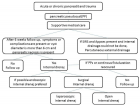Abstract
Research Article
Improvement of the Deterioration of the Gut Microbiota Due to High-fat, High-sucrose Diet Acylated Steryl-β-glycosides Intake
Masaki Iji, Kuniyuki Yamada, Yuta Yamane, Chihiro Watanabe, Kazuhito Takemoto, Mamoru Tanaka, Yuichiro Takei, Takako Miyaue, Yoichi Miura and Hiroyuki Watanabe*
Published: 20 July, 2023 | Volume 7 - Issue 1 | Pages: 065-069
Daily high-fat diet (HFD) intake is generally associated with an increased risk of metabolic diseases, cancer, and neurological disorders, which represent a major global health burden with significant social and economic consequences. In the present study, mice were treated with HFD containing 40% lipids. Furthermore, HFD was supplemented with 0.5% or 1.0% acylated sterol-β-glucoside (ASG).
After 55 days of rearing, body weight, epididymal fat weight, weight, and pH of cecum contents and intestinal microflora were compared with mice fed HFD or a low-fat diet (LFD) containing lipid at 7%. The results showed that body weight and epididymis fat weight on the last day of feeding were significantly higher in HFD, 0.5% ASG, and 1.0% ASG compared to LFD, but significantly lower in 0.5% ASG and 1.0% ASG compared to HFD. Cecum content weight was lower with HFD compared to LFD but increased to LFD levels with the addition of ASG. Cecum pH was significantly lower on the 1.0% ASG compared to the other groups.
The gut microbiota was significantly elevated in the HFD compared to the LFD, with Bacilliota specific to obese mice. However, the addition of ASG to the HFD decreased the Bacilliota and increased the Bacteroidota. Clostridium cluster XI and Clostridium subcluster XIVa, intestinal bacteria involved in the production of carcinogenic secondary bile acids, were markedly increased by consumption of the HFD but were markedly decreased by ASG.
Daily intake of ASG may inhibit the deterioration of gut bacteria caused by HFD and reduce the disease risk posed by HFD.
Read Full Article HTML DOI: 10.29328/journal.afns.1001051 Cite this Article Read Full Article PDF
Keywords:
High-fat diet; Plant sterol; Intestinal bacterial flora; Obese; Body fat
References
- Feskens EJ, Virtanen SM, Räsänen L, Tuomilehto J, Stengård J, Pekkanen J, Nissinen A, Kromhout D. Dietary factors determining diabetes and impaired glucose tolerance. A 20-year follow-up of the Finnish and Dutch cohorts of the Seven Countries Study. Diabetes Care. 1995 Aug;18(8):1104-12. doi: 10.2337/diacare.18.8.1104. PMID: 7587845.
- Carroll KK, Braden LM, Bell JA, Kalamegham R. Fat and cancer. Cancer. 1986 Oct 15;58(8 Suppl):1818-25. doi: 10.1002/1097-0142(19861015)58:8+<1818::aid-cncr2820581406>3.0.co;2-4. PMID: 3756806.
- Kalmijn S, Launer LJ, Ott A, Witteman JC, Hofman A, Breteler MM. Dietary fat intake and the risk of incident dementia in the Rotterdam Study. Ann Neurol. 1997 Nov;42(5):776-82. doi: 10.1002/ana.410420514. PMID: 9392577.
- Zhang M, Yang XJ. Effects of a high fat diet on intestinal microbiota and gastrointestinal diseases. World J Gastroenterol. 2016 Oct 28;22(40):8905-8909. doi: 10.3748/wjg.v22.i40.8905. PMID: 27833381; PMCID: PMC5083795.
- Grille S, Zaslawski A, Thiele S, Plat J, Warnecke D. The functions of steryl glycosides come to those who wait: Recent advances in plants, fungi, bacteria and animals. Prog Lipid Res. 2010 Jul;49(3):262-88. doi: 10.1016/j.plipres.2010.02.001. Epub 2010 Feb 6. PMID: 20138912.
- Ikeda I, Tanaka K, Sugano M, Vahouny GV, Gallo LL. Inhibition of cholesterol absorption in rats by plant sterols. J Lipid Res. 1988 Dec;29(12):1573-82. PMID: 2468730.
- Cedó L, Farràs M, Lee-Rueckert M, Escolà-Gil JC. Molecular Insights into the Mechanisms Underlying the Cholesterol- Lowering Effects of Phytosterols. Curr Med Chem. 2019;26(37):6704-6723. doi: 10.2174/0929867326666190822154701. PMID: 31438826.
- Vezza T, Canet F, de Marañón AM, Bañuls C, Rocha M, Víctor VM. Phytosterols: Nutritional Health Players in the Management of Obesity and Its Related Disorders. Antioxidants (Basel). 2020 Dec 12;9(12):1266. doi: 10.3390/antiox9121266. PMID: 33322742; PMCID: PMC7763348.
- Nagashima K, Hisada T, Sato M, Mochizuki J. Application of new primer-enzyme combinations to terminal restriction fragment length polymorphism profiling of bacterial populations in human feces. Appl Environ Microbiol. 2003 Feb;69(2):1251-62. doi: 10.1128/AEM.69.2.1251-1262.2003. PMID: 12571054; PMCID: PMC143637.
- Chakraborti CK. New-found link between microbiota and obesity. World J Gastrointest Pathophysiol. 2015 Nov 15;6(4):110-9. doi: 10.4291/wjgp.v6.i4.110. PMID: 26600968; PMCID: PMC4644874.
- Kobayashi R, Nagaoka K, Nishimura N, Koike S, Takahashi E, Niimi K, Murase H, Kinjo T, Tsukahara T, Inoue R. Comparison of the fecal microbiota of two monogastric herbivorous and five omnivorous mammals. Anim Sci J. 2020 Jan-Dec;91(1):e13366. doi: 10.1111/asj.13366. PMID: 32285557; PMCID: PMC7216987.
- Turnbaugh PJ, Ley RE, Mahowald MA, Magrini V, Mardis ER, Gordon JI. An obesity-associated gut microbiome with increased capacity for energy harvest. Nature. 2006 Dec 21;444(7122):1027-31. doi: 10.1038/nature05414. PMID: 17183312.
- Ley RE, Turnbaugh PJ, Klein S, Gordon JI. Microbial ecology: human gut microbes associated with obesity. Nature. 2006 Dec 21;444(7122):1022-3. doi: 10.1038/4441022a. PMID: 17183309.
- Duca FA, Lam TK. Gut microbiota, nutrient sensing and energy balance. Diabetes Obes Metab. 2014 Sep;16 Suppl 1:68-76. doi: 10.1111/dom.12340. PMID: 25200299.
- Kairupan TS, Amitani H, Cheng KC, Runtuwene J, Asakawa A, Inui A. Role of gastrointestinal hormones in feeding behavior and obesity treatment. J Gastroenterol. 2016 Feb;51(2):93-103. doi: 10.1007/s00535-015-1118-4. Epub 2015 Sep 7. PMID: 26346735.
- Genton L, Cani PD, Schrenzel J. Alterations of gut barrier and gut microbiota in food restriction, food deprivation and protein-energy wasting. Clin Nutr. 2015 Jun;34(3):341-9. doi: 10.1016/j.clnu.2014.10.003. Epub 2014 Oct 12. PMID: 25459400.
- Qin D, Ma Y, Wang Y, Hou X, Yu L. Contribution of Lactobacillion Intestinal Mucosal Barrier and Diseases: Perspectives and Challenges of Lactobacillus casei. Life (Basel). 2022 Nov 16;12(11):1910. doi: 10.3390/life12111910. PMID: 36431045; PMCID: PMC9696601.
- Rossi F, Amadoro C, Colavita G. Members of the LactobacillusGenus Complex (LGC) as Opportunistic Pathogens: A Review. Microorganisms. 2019 May 10;7(5):126. doi: 10.3390/microorganisms7050126. PMID: 31083452; PMCID: PMC6560513.
- Bron PA, Tomita S, Mercenier A, Kleerebezem M. Cell surface-associated compounds of probiotic lactobacilli sustain the strain-specificity dogma. Curr Opin Microbiol. 2013 Jun;16(3):262-9. doi: 10.1016/j.mib.2013.06.001. Epub 2013 Jun 28. PMID: 23810459.
- Teame T, Wang A, Xie M, Zhang Z, Yang Y, Ding Q, Gao C, Olsen RE, Ran C, Zhou Z. Paraprobiotics and Postbiotics of Probiotic Lactobacilli, Their Positive Effects on the Host and Action Mechanisms: A Review. Front Nutr. 2020 Oct 22;7:570344. doi: 10.3389/fnut.2020.570344. PMID: 33195367; PMCID: PMC7642493.
- Payne CM, Weber C, Crowley-Skillicorn C, Dvorak K, Bernstein H, Bernstein C, Holubec H, Dvorakova B, Garewal H. Deoxycholate induces mitochondrial oxidative stress and activates NF-kappaB through multiple mechanisms in HCT-116 colon epithelial cells. Carcinogenesis. 2007 Jan;28(1):215-22. doi: 10.1093/carcin/bgl139. Epub 2006 Aug 3. PMID: 16887864.
- Ridlon JM, Kang DJ, Hylemon PB. Bile salt biotransformations by human intestinal bacteria. J Lipid Res. 2006 Feb;47(2):241-59. doi: 10.1194/jlr.R500013-JLR200. Epub 2005 Nov 18. PMID: 16299351.
Figures:
Similar Articles
-
Improvement of the Deterioration of the Gut Microbiota Due to High-fat, High-sucrose Diet Acylated Steryl-β-glycosides IntakeMasaki Iji, Kuniyuki Yamada, Yuta Yamane, Chihiro Watanabe, Kazuhito Takemoto, Mamoru Tanaka, Yuichiro Takei, Takako Miyaue, Yoichi Miura, Hiroyuki Watanabe*. Improvement of the Deterioration of the Gut Microbiota Due to High-fat, High-sucrose Diet Acylated Steryl-β-glycosides Intake. . -0001 doi: ; 7: 065-069
-
Improvement of the Deterioration of the Gut Microbiota Due to High-fat, High-sucrose Diet Acylated Steryl-β-glycosides IntakeMasaki Iji, Kuniyuki Yamada, Yuta Yamane, Chihiro Watanabe, Kazuhito Takemoto, Mamoru Tanaka, Yuichiro Takei, Takako Miyaue, Yoichi Miura, Hiroyuki Watanabe*. Improvement of the Deterioration of the Gut Microbiota Due to High-fat, High-sucrose Diet Acylated Steryl-β-glycosides Intake. . 2023 doi: 10.29328/journal.afns.1001051; 7: 065-069
Recently Viewed
-
Unveiling the Impostor: Pulmonary Embolism Presenting as Pneumonia: A Case Report and Literature ReviewSaahil Kumar,Karuna Sree Alwa*,Mahesh Babu Vemuri,Anumola Gandhi Ganesh Gupta,Nuthan Vallapudasu,Sunitha Geddada. Unveiling the Impostor: Pulmonary Embolism Presenting as Pneumonia: A Case Report and Literature Review. J Pulmonol Respir Res. 2025: doi: 10.29328/journal.jprr.1001065; 9: 001-005
-
Evolving Paradigms in Strep Throat: From Epidemiology to Advanced Therapeutics - A Comprehensive OverviewSai YRKM*. Evolving Paradigms in Strep Throat: From Epidemiology to Advanced Therapeutics - A Comprehensive Overview. Heighpubs Otolaryngol Rhinol. 2022: doi: 10.29328/journal.hor.1001025; 6: 001-010
-
Drinking-water Quality Assessment in Selective Schools from the Mount LebanonWalaa Diab, Mona Farhat, Marwa Rammal, Chaden Moussa Haidar*, Ali Yaacoub, Alaa Hamzeh. Drinking-water Quality Assessment in Selective Schools from the Mount Lebanon. Ann Civil Environ Eng. 2024: doi: 10.29328/journal.acee.1001061; 8: 018-024
-
Efficiency of Artificial Intelligence for Interpretation of Chest Radiograms in the Republic of TajikistanBobokhojaev OI*,Abdulloev NN,Khushvakhtov ShD,Shukurov SG. Efficiency of Artificial Intelligence for Interpretation of Chest Radiograms in the Republic of Tajikistan. J Pulmonol Respir Res. 2024: doi: 10.29328/journal.jprr.1001064; 8: 069-073
-
Decline in human sperm parameters: How to stop?Aboubakr Mohamed Elnashar*. Decline in human sperm parameters: How to stop?. Clin J Obstet Gynecol. 2023: doi: 10.29328/journal.cjog.1001122; 6: 016-020
Most Viewed
-
Sinonasal Myxoma Extending into the Orbit in a 4-Year Old: A Case PresentationJulian A Purrinos*, Ramzi Younis. Sinonasal Myxoma Extending into the Orbit in a 4-Year Old: A Case Presentation. Arch Case Rep. 2024 doi: 10.29328/journal.acr.1001099; 8: 075-077
-
Evaluation of Biostimulants Based on Recovered Protein Hydrolysates from Animal By-products as Plant Growth EnhancersH Pérez-Aguilar*, M Lacruz-Asaro, F Arán-Ais. Evaluation of Biostimulants Based on Recovered Protein Hydrolysates from Animal By-products as Plant Growth Enhancers. J Plant Sci Phytopathol. 2023 doi: 10.29328/journal.jpsp.1001104; 7: 042-047
-
Feasibility study of magnetic sensing for detecting single-neuron action potentialsDenis Tonini,Kai Wu,Renata Saha,Jian-Ping Wang*. Feasibility study of magnetic sensing for detecting single-neuron action potentials. Ann Biomed Sci Eng. 2022 doi: 10.29328/journal.abse.1001018; 6: 019-029
-
Physical activity can change the physiological and psychological circumstances during COVID-19 pandemic: A narrative reviewKhashayar Maroufi*. Physical activity can change the physiological and psychological circumstances during COVID-19 pandemic: A narrative review. J Sports Med Ther. 2021 doi: 10.29328/journal.jsmt.1001051; 6: 001-007
-
Pediatric Dysgerminoma: Unveiling a Rare Ovarian TumorFaten Limaiem*, Khalil Saffar, Ahmed Halouani. Pediatric Dysgerminoma: Unveiling a Rare Ovarian Tumor. Arch Case Rep. 2024 doi: 10.29328/journal.acr.1001087; 8: 010-013

HSPI: We're glad you're here. Please click "create a new Query" if you are a new visitor to our website and need further information from us.
If you are already a member of our network and need to keep track of any developments regarding a question you have already submitted, click "take me to my Query."

















































































































































